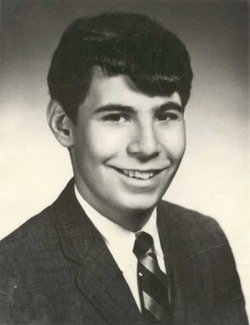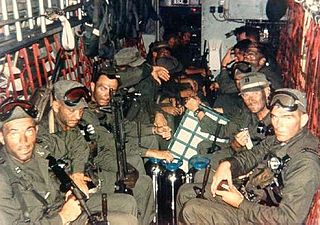
Vietnamization was a policy of the Richard Nixon administration to end U.S. involvement in the Vietnam War through a program to "expand, equip, and train South Vietnamese forces and assign to them an ever-increasing combat role, at the same time steadily reducing the number of U.S. combat troops". Brought on by the Viet Cong's Tet Offensive, the policy referred to U.S. combat troops specifically in the ground combat role, but did not reject combat by the U.S. Air Force, as well as the support to South Vietnam, consistent with the policies of U.S. foreign military assistance organizations. U.S. citizens' mistrust of their government that had begun after the offensive worsened with the release of news about U.S. soldiers massacring civilians at My Lai (1968), the invasion of Cambodia (1970), and the leaking of the Pentagon Papers (1971).

Jeffrey Glenn Miller was an American student at Kent State University in Kent, Ohio, who was killed by the Ohio Army National Guard in the Kent State shootings. He had been protesting against the invasion of Cambodia and the presence of the National Guard on the Kent State campus. National Guardsmen opened fire on a group of unarmed students, killing Miller and three others.
The Jackson State killings occurred on Friday, May 15, 1970, at Jackson State College in Jackson, Mississippi. On May 14, 1970, city and state police confronted a group of students outside a campus dormitory. Shortly after midnight, the police opened fire, killing two students and injuring twelve. The event happened 11 days after the Kent State shootings, in which National Guardsmen killed four students at Kent State University in Ohio during a protest against the Vietnam War. The Kent State event had first captured national attention.

William Warren Scranton was an American Republican Party politician and diplomat. Scranton served as the 38th governor of Pennsylvania from 1963 to 1967, and as United States Ambassador to the United Nations from 1976 to 1977. "Many who serve as governor today are still measured against Bill Scranton's leadership - some 50 years later," said former state Republican National Committeewoman Elsie Hillman when she learned of Scranton's death in 2013.

Allison Beth Krause was a student at Kent State University and one of four unarmed students shot and killed by soldiers of the Ohio Army National Guard in the May 4, 1970 Kent State shootings in Kent, Ohio. The shootings occurred as students protested against both the invasion of Cambodia and the National Guard presence on campus.

Opposition to United States involvement in the Vietnam War began with demonstrations in 1965 against the escalating role of the United States in the Vietnam War and grew into a broad social movement over the ensuing several years. This movement informed and helped shape the vigorous and polarizing debate, primarily in the United States, during the second half of the 1960s and early 1970s on how to end the Vietnam War.

The Hard Hat Riot occurred on May 8, 1970, in New York City. It started around noon when around 400 construction workers and around 800 office workers attacked around 1,000 demonstrators affiliated with the student strike of 1970. The students were protesting the May 4 Kent State shootings and the Vietnam War, following the April 30 announcement by President Richard Nixon of the U.S. invasion of neutral Cambodia. Some construction workers carried U.S. flags and chanted "USA, All the way", and "America, love it or leave it". Anti-war protesters shouted, “Peace now”.

Operation Menu was a covert United States Strategic Air Command (SAC) tactical bombing campaign conducted in eastern Cambodia from 18 March 1969 to 26 May 1970 as part of both the Vietnam War and the Cambodian Civil War. The targets of these attacks were sanctuaries and base areas of the People's Army of Vietnam and forces of the Viet Cong (VC), which used them for resupply, training, and resting between campaigns across the border in the Republic of Vietnam. The impact of the bombing campaign on the Khmer Rouge guerrillas, the PAVN, and Cambodian civilians in the bombed areas is disputed by historians.
LeRoy Martin Satrom was an American politician and engineer in Portage County, Ohio. He served as county engineer, city engineer, city councilman, and mayor. Satrom is most remembered for his 1970–1972 tenure as mayor of Kent, Ohio, specifically for his request for National Guard assistance in the events leading up to the May 4, 1970 Kent State shootings, where four students were killed and nine wounded. He later served four terms as Portage County engineer, and retired in 1988.

The Cambodian campaign was a series of military operations conducted in eastern Cambodia in mid-1970 by South Vietnam and the United States as an expansion of the Vietnam War and the Cambodian Civil War. Thirteen operations were conducted by the Army of the Republic of Vietnam (ARVN) between April 29 and July 22 and by U.S. forces between May 1 and June 30, 1970.

The Ohio National Guard comprises the Ohio Army National Guard and the Ohio Air National Guard. The commander-in-chief of the Ohio Army National Guard is the governor of the U.S. state of Ohio. If the Ohio Army National Guard is called to federal service, then the President of the United States becomes the commander-in-chief. The military commander of all forces in the State of Ohio is the Adjutant General, Major General John C. Harris, Jr. is responsible for the command of 17,000 members, preparedness and readiness, installation management, and budget of the Ohio National Guard. The current Assistant Adjutant General for Army, with responsibility for overseeing the Ohio Army National Guard training and operations, is Brigadier General Thomas E. Moore II. The current Assistant Adjutant General for Air is Major General James R. Camp with responsibility for overseeing the Ohio Air National Guard.

Joseph Rhodes Jr. was an American politician and activist. From 1972–1980, he served four 2-year terms as a member of the Pennsylvania House of Representatives. He was a commissioner of the Pennsylvania Public Utility Commission from 1988–1995. He served as a member of several public panels, including the President's Commission on Campus Unrest that investigated the fatal shootings of unarmed student protesters by soldiers and police in 1970 at Kent State and Jackson State Universities.

The Kent State shootings was the killing of four and wounding of nine unarmed college students by the Ohio National Guard, on the Kent State University campus. The shootings took place on May 4, 1970, during a rally opposing the expanding involvement of the Vietnam War into Cambodia by United States military forces as well as protesting the National Guard presence on campus and the draft.

The student strike of 1970 was a massive protest across the United States that included walk-outs from college and high school classrooms, initially in response to the United States expansion of the Vietnam War into Cambodia. Nearly 900 campuses nationwide participated. The strike began May 1, but increased significantly after the shooting of students at Kent State University by National Guardsmen on May 4. While many violent incidents occurred during the protests, they were, for the most part, peaceful.

The United States continued its unilateral withdrawal of forces from South Vietnam notwithstanding the lack of progress at the Paris Peace Talks. The removal of Prince Norodom Sihanouk from power in Cambodia in March and his replacement by General Lon Nol, began the Cambodian Civil War. South Vietnamese and U.S. forces entered Cambodia in late April to attack People's Army of Vietnam (PAVN) and Vietcong (VC) bases and supply lines there which had long been used to support the insurgency in South Vietnam. The expansion of the war revitalized the antiwar movement in the U.S. and led to the Kent State shootings and Jackson State killings in May. While U.S. ground forces withdrew from Cambodia at the end of June and legislation was passed to prevent their reintroduction, the South Vietnamese conducted operations in Cambodia for the rest of the year and the U.S. provided air support and military aid to the Cambodian government. Despite this support the Cambodians lost control of vast areas of the country to the PAVN. Within South Vietnam the second half of the year saw a reduction in large U.S. operations with the focus shifting to pacification and population security and supporting Vietnamization. The PAVN/VC generally reverted to sapper attacks and attacks by fire but they fought hard to defend their base areas and infiltration routes.

Woodstock West is the name University of Denver students gave to the shanty village that they built while protesting the school's decision to stay open after the Kent State shootings.
This is a bibliography on the Kent State shootings. External links to reports, news articles and other sources of information may also be found below.
Meyer “Mike” Alewitz is an educator, agitprop artist, mural painter, and political activist, working both in the United States and internationally. His use of art to lobby for workers’ rights has fostered numerous controversies. His approach has been described as “ideally suited to the postmodern and post-state socialist era, when everything rebellious must be created anew and when ‘culture' along with ‘labor’ are urgently needed to salvage a world from eco-disaster, perpetual war, and the plundering of human possibility.”

The following events occurred in May 1970:
The University of New Mexico bayoneting incident was a violent altercation between students protesting on the campus of the University of New Mexico (UNM) and the New Mexico Army National Guard that took place on May 8, 1970, in Albuquerque, New Mexico. Students protested on campus for several days leading up to the incident as a response to the Kent State shooting that had happened four days prior. The protest was also part of a larger series of anti-war demonstrations that occurred on college campuses across the United States during the late 1960s and early 1970s to voice opposition to US involvement in the Vietnam War. In the days leading up to the incident, students occupied the Student Union and Air Force ROTC buildings on campus, which led to UNM President Ferrel Heady and the Board of Regents' decision to court order the temporary closure of the Student Union Building. Heady encouraged students to leave, and many did before police arrested the remaining 131 protesters. As the building was being cleared out, the National Guard arrived and bayoneted a crowd that had gathered around the Student Union Building. During the incident, 10 or 11 people including students, teachers, and media members received bayonet wounds, though no deaths occurred.















